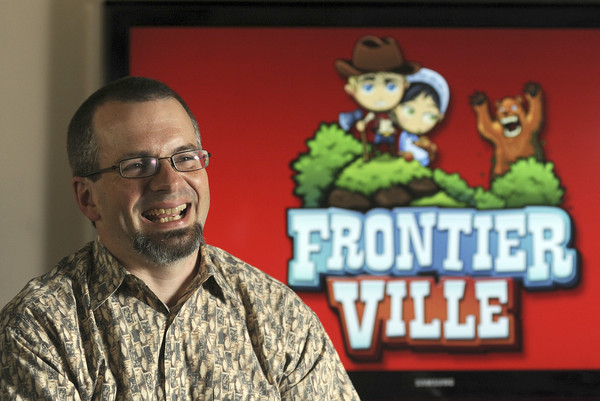巴尔的摩太阳报:新疆域-zynga东区办公室和在线社交游戏
在社交游戏黑帮战争(Mafia Wars)中,你可以招募朋友进入到虚拟世界的犯罪集团中。在FarmVille中,你可以与朋友互相照看虚拟宠物。
欢迎来到Zynga创造的在线社交游戏世界,它是一家旧金山的公司,去年它在巴尔的摩开设了工作室。该办公室叫作“Zynga东区(Zynga East)”,负责FrontierVille的开发,该游戏是Zynga第二大游戏,拥有3500万名用户。
Zynga东区
巴尔的摩已经成为游戏的前沿阵地,Zynga东区也准备扩张规模。Zynga首席游戏设计师布赖恩·雷诺兹(Brian Reynolds)说:“这是娱乐产业,我们要不断推出新品。我们既要寻找到新的热点,又要让人们有理由沉醉并不断玩它。”
在美国马里兰州,数字媒体产业达55亿美元,电脑游戏只是当中的一部分,最近十年游戏业增长迅速。随着社交网的升温,社交游戏也大行其道。
社交游戏是游戏新方式
在十九世纪九十年代,由于个人电脑的兴趣,电脑游戏迅速发展。近几年来,游戏玩家开始转向了专用的游戏机。不过在过去几年,社交网的流行也给休闲游戏带来发展空间。
NPD分析师Anita Frazier说:“一些游戏的成功是以消费者的昂贵游戏内容消费为代价的。而自社交游戏兴起后,玩家们的支出减少了20%。”
相比于电脑或者专业游戏机的游戏,在线社交游戏并不复杂,也不令人炫目,但它允许用户免费玩,与朋友而不是与陌生人玩。这才是关键的功能。
美国马里兰大学计算机教授马克·奥兰多(Marc Olano)说:“随着游戏产业的发展,它派生出一些原来没有的新方式。对于一些不喜欢跑来跑去、或者长时间耗在专业游戏机上的玩家来说,这恰恰是一个新的方式。”
社交游戏与传统电脑、游戏机游戏的区别
FrontierVille的创意从何而来呢?布赖恩·雷诺兹与其它一些高管在Zynga开会,包括首席执行官马克·平卡斯(Mark Pincus),创意是从会上开出来的。雷诺兹说,两年前就对Facebook很感兴趣,当他听到人们在为服务搭建游戏时,就更兴奋了。
雷诺兹随后谈到了社交游戏与传统电脑游戏、游戏机游戏的两点不同:
在线社交游戏与传统电脑游戏的玩家有所不同。在最新的社交游戏世界,企业必须用网络技术来建立和支持自己的游戏,它的开发周期更短,一年或者更短的时间,而传统的PC或者视频游戏机游戏开发周期长达2-5年。社交游戏的设计是为了更多的休闲玩家,它可能只在线5-10 分钟,而一款独立的游戏要玩上几个小时。因此社交游戏在设计时就必须配置一些元素,能说服用户付钱。
社交游戏与传统游戏还有一个不同,开发完一款社交游戏后,一个工作室不会又去开发另一款。如果游戏成功了,Zynga会保持员工的增长,开发技术和设计架构来支持数百万的在线用户。
寻找新热点是大挑战
对于Zynga和其它社交游戏商来说,最大的挑战是开发热门的游戏吸引用户。Zynga面临来自Playfish和Playdom的竞争,还有传言说Google也准备推出在线游戏网络。
NPD分析师Frazier说:“那儿有大量的游戏,我们的研究显示只有少数能吸引足够多的用户。要脱颖而出、吸引玩家注意绝非易事。”
在过去几年,Zynga已经开发出超过40款游戏,当中的三分之一已经中止。
FrontierVille至今是成功的。Zynga东区拥有约30名员工,包括开发工程师、设计师、制作人和分析师。在旧金山还有30名员工支持游戏。现在Zynga共有约1100名员工。
雷诺兹说,希望巴尔的摩的游戏开发产业能在社交游戏领域更为重要。
In Mafia Wars, you recruit your friends into a virtual world of organized crime. In FarmVille, you and your friends help each other tend virtual animals and plots of land. And in FrontierVille, you endeavor to build a frontier town in the Wild West.
Welcome to the universe of online social games crafted by Zynga Game Network Inc. — a thriving San Francisco-based company that launched a major game design studio in Baltimore County last year.
That office, known as Zynga East, was responsible in June for creating and launching FrontierVille, the company’s second most popular game behind FarmVille, with nearly 35 million users.
For Baltimore County, where video-gaming expertise has clustered in companies in Timonium and Hunt Valley, Zynga’s presence serves to solidify the region’s standing as a top destination for video game designers. Zynga East has already outgrown its office and is planning to move soon to a nearby space that’s triple the size, at 9,000 square feet.
“This is the entertainment industry,” said Brian Reynolds, chief game designer for Zynga and head of the Timonium office and local gaming industry veteran. “We need to keep launching new products.
We have to both find the new hits and give people a reason to get involved and keep playing.”
Customized. Optimized. Pocket sized. Buy the new Baltimore Sun iPhone app.
The computer gaming sector in Maryland is part of the state’s $5.5 billion digital media industry, which has grown rapidly in recent decades, according to a recent study commissioned by the Maryland Department of Business and Economic Development and the state Film Office.
With hundreds of games on mobile devices or online social networks like Facebook or MySpace, social gaming is hot right now — and Zynga is one of the top companies in the field.
Driving the growth is Facebook, which has become an online juggernaut, amassing more than 500 million users across the world. Online social games by Zynga have been embraced by Facebook users, millions of whom spend hours each day playing the company’s games.
Many also spend real money to buy virtual goods that enhance their game play, thus turning Zynga into a virtual money-making machine with reportedly hundreds of millions of dollars in annual revenue. (The private company doesn’t release revenue figures.)
According to a report by Inside Network, the sale of virtual goods is expected be a $1.6 billion industry this year in the United States.
For gaming industry veterans, companies such as Zynga and its peers represent an exciting new expansion. In the 1980s, video gaming was tied to the new personal computers that emerged. Gamers then turned their attention to playing on dedicated consoles, such as those offered by Atari and Nintendo. More recently, Microsoft, Sony and Nintendo have dominated the console market.
But in the past few years, online games on popular social-networking websites such as Facebook have attracted droves of casual gamers. To some extent, social games have poached players from other types of games.
“The success of some of these games has been at the expense of consumer spending on games content overall,” said Anita Frazier, an industry analyst with the NPD Group, a market research firm in New York. “Gamers report spending 20 percent less on gaming overall since they took up social network gaming.”
Online social games typically aren’t as complicated or visually stunning as their computer or console counterparts, but they enable people to play for free with friends and not just with strangers online, as is often the case with other games. That’s a key feature, industry experts said.
“The games industry, to grow, is finding ways to branch out in other things where they haven’t been before,” said Marc Olano, a computer science professor at the University of Maryland, Baltimore County and director of the computer science game development track.
“It’s just a new way to reach people who maybe don’t like running around blowing things up or don’t like the long-term time commitment” of computer or console games, Olano added.
The idea for FrontierVille came out of a high-level executive meeting between Brian Reynolds and others at Zynga, including chief executive Mark Pincus. Reynolds, who works in Zynga’s Timonium office, joined the company in May of last year with a top reputation in the field.
He had worked at MicroProse, one of the first gaming companies in the Baltimore area in the early 1980s. Later, he co-founded two other local game studios: Firaxis and Big Huge Games.
Reynolds said he became excited about Facebook two years ago, and doubly so when he learned that people were building games for the service.
He sees some big differences between online social games and the games he used to design for traditional computer players. In the newer social gaming world, companies have to use Internet technologies to build and support their games. The development window is shorter, a year or less for online social games, compared with two to five years in PC and console games.
The games themselves are designed for a more casual user, who might have only five to 10 minutes to play online, rather than dedicated gamers who might play for hours at a time. Along the way, social game designers have to design little hooks in the game to persuade people to spend real money, on improving their virtual farm, for instance.
(A small percentage of users pay to enhance their game play — the primary source of revenue for Zynga — while the vast majority play for free, according to the company.)
Another difference with traditional games, Reynolds said, is that game shops like Zynga East don’t just build an online social game and move on to another new one. If the game is successful, Zynga has to maintain a growing staff, as well as technological and design infrastructure to support the millions of online users.
The challenge for Zynga and others is to design a game that becomes a viral hit with online users. Zynga faces competition from other big social gaming companies, such as Playfish and Playdom, and there is speculation that Google might launch an online gaming network.
“There are a ton of these games out there, yet our study showed that there are only a handful that are attracting a meaningful audience,” said NPD’s Frazier. “So it’s hard to break through the clutter of games to attract players’ attention.”
Over the years, Zynga has introduced more than 40 online games, and has discontinued about a third of them.
FrontierVille, for now, is successful. At the moment, Zynga East has about 30 employees — programmers, designers, producers and analysts — who work exclusively on supporting that game. Another 30 employees work to support the game out of the San Francisco office. Zynga employs a total of more than 1,100 people.
Reynolds said he wants to see the Baltimore area’s game development industry get more heavily into online social gaming.
That’s already starting to happen at Firaxis Games in Hunt Valley. Sid Meier, creative director for Firaxis and one of the co-founders of MicroProse, said his company will soon be coming out with Civilization Network, a Facebook game for its popular Civilization series, which have sold in the millions.
“For some of us, for Brian and myself, it’s almost like a return to the good old days, where we did a game in three to six months rather than two years,” Meier said. “It’s fun to make games for a new platform. It adds new opportunities. It’s a really positive development.”(source:baltimore sun/sohu)









































 闽公网安备35020302001549号
闽公网安备35020302001549号